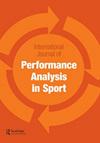2021年欧洲锦标赛400米、800米和1500米自由泳项目的速度概况、变化和进展
IF 1.6
4区 教育学
Q1 Health Professions
International Journal of Performance Analysis in Sport
Pub Date : 2021-12-21
DOI:10.1080/24748668.2021.2010318
引用次数: 9
摘要
摘要:在长距离游泳中,还没有对表现的内部变异性进行研究。目的是描述400米、800米和1500米自由泳项目的起搏情况,并分析轮内和轮间的变异性(变异系数[CV])和表现进展(%Δ)。在2021年欧洲锦标赛(室内长程)上,对130名精英游泳运动员(70名男性和60名女性)的256次游泳进行了分析。将线性混合效应模型应用于每个游泳运动员和比赛时间的表现,以获得每圈和每轮(即预赛和决赛)之间的CV和%Δ。采用T检验比较奖牌获得者和非奖牌获得者的CV。与速度均匀的中间圈相比,第一圈和最后一圈是所有项目中最快的(p<0.001)。所有项目均采用抛物线起搏模式。男性游泳运动员在两轮比赛之间的CV平均值为0.52±0.49%(-0.64±0.8%Δ),女性游泳运动员的CV平均为0.70±0.45(-0.71±0.92%Δ)。与非奖牌获得者(0.22–0.47%)相比,奖牌获得者在两轮之间的CV更高(1.00–1.08%)。400米、800米和1500米比赛采用抛物线起搏模式。最好的游泳运动员在预赛中采取保守的策略来提高他们在决赛中的表现,在两回合之间获得更高的CV和%Δ。本文章由计算机程序翻译,如有差异,请以英文原文为准。
Pacing profiles, variability and progression in 400, 800 and 1500-m freestyle swimming events at the 2021 European Championship
ABSTRACT Performance intra-variability has not been studied in long-distance swimming. The aims were to describe the pacing profile in 400-, 800- and 1500-m freestyle events and to analyse the variability (coefficient of variation[CV]) and performance progression (%Δ) within and between rounds. A total of 256 swims of 130 elite-swimmers (70 males and 60 females) were analysed at the 2021 European Championship (indoor long-course). Linear mixed-effect models were applied for each swimmer and race time performances to obtain the CV and %Δ between each lap and rounds (i.e. heats and final). T-test was conducted to compare the CV between medallist and non-medallist. First and last laps were the fastest (p < 0.001) in all events compared to the intermediate laps which showed an evenly-pace. Parabolic pacing profile was adopted in all events. Male swimmers obtained a CV-average of 0.52 ± 0.49% between rounds (−0.64 ± 0.8%Δ) and females, a CV-average of 0.70 ± 0.45 (−0.71 ± 0.92%Δ). Medallist swimmers obtained higher CV between rounds (1.00–1.08%) compared to non-medallist finalist (0.22–0.47%). Parabolic pacing profiles were adopted in 400-, 800-, and 1500-m races. The best swimmers adopt conservative strategies in heats to improve their performance in final, obtaining higher CV and %Δ between rounds.
求助全文
通过发布文献求助,成功后即可免费获取论文全文。
去求助
来源期刊

International Journal of Performance Analysis in Sport
SPORT SCIENCES-
CiteScore
4.70
自引率
4.80%
发文量
38
审稿时长
>12 weeks
期刊介绍:
The International Journal of Performance Analysis in Sport aims to present current original research into sports performance. In so doing, the journal contributes to our general knowledge of sports performance making findings available to a wide audience of academics and practitioners.
 求助内容:
求助内容: 应助结果提醒方式:
应助结果提醒方式:


